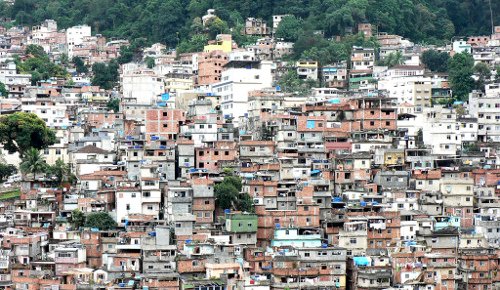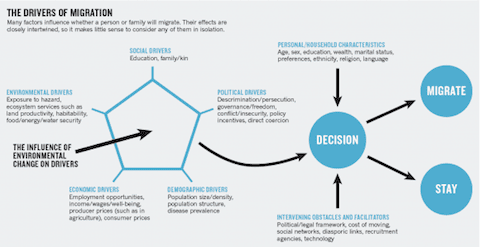
This post is taken from Carlo Carraro’s Blog (published 011/03/15)
In the coming decades, climate change will expose hundreds of millions of people to its impacts. As shown by the latest research (see the summary in the second volume of the IPCC Fifth Assessment Report on Climate Change (AR5), some parts of the world will be more vulnerable than others to these impacts. Aside from the increase in average temperature and changes in precipitation, many areas will have to deal with extreme weather conditions such as heatwaves, droughts and floods, increasingly becoming the norm. This, in turn, leads to serious implications for water supplies, crops, health, and economic growth. Some areas will be relatively less exposed to these pressures due to their geographic location or ability to respond and adapt better. Given that climate change is and will continue to impact regions in different ways, the migration of individuals and communities from the areas most exposed to climate change impacts needs to be considered.
Impacts of climate change and migration
Climate change will make some areas less habitable. It is not uncommon to hear predictions that there will be mass migrations away from the areas most affected by climate impacts. These predictions focus on “climate refugees” who leave their homeland for more hospitable areas with less exposure to drought and other climate extremes. Such migrations can sometimes cause conflicts between locals as they vie for increasingly scarce arable land (Reuveny, 2007; Ghimire et al. 2015)[1]. Millions of people are expected to migrate from South to North, from coasts exposed to sea level rise to higher plains, and from increasingly arid areas to more fertile ones. According to the International Organization of Migration[2], there may be between 25 million and one billion climate migrants over the next 40 years. The article “Accommodating Migration to Promote Adaptation to Climate Change” (by Barnett and Webber) provides an overview of research on climate migration dating from 1988 when climate change was first identified as a possible driver of migration. However, it is important to avoid depicting the migration of people due to climate change as a disaster. To this end, we need to better understand not only the causes, but the whole migration process. This includes understanding that climate change induced poverty might even reduce some forms of international migration or at least limit it to certain sections of the population, ironically, those better off.
Displacement and migration: two ends of the spectrum
First, it is necessary to distinguish between migration that results from extreme events and migration resulting from long-term changes in temperature and rainfall. The former – extreme event migration – bears many of the hallmarks of displacement. In 2008, 20 million people were displaced as a result of extreme weather events (data from the International Organization of Migration). This is not a figure to belittle. Especially when you consider that 4.6 million people were displaced by conflict and violence in the same year. The Asian Development Bank cites the displacement of 42 million people due to extreme events between 2010 and 2011.
These cases of displacement, unlike the migration, are not voluntary decisions and permanent transitions. While defining displacement as movement dictated by a specific and often temporary or short term event, we can define migration as a long-term choice that often involves relocated over large spaces. Though we draw this stark divide, there are certainly a number of case studies lying between the two. For instance, migration in response to a drought-induced food crisis is not as immediate a decision as migration due to an extreme event. However, it is certainly more immediate than migration linked to the degradation of natural resources, which occur over a longer term scale. Such degradation might include deforestation, forest degradation, fish stock decline, crop changes, and coral reef destruction.
Moreover, not only are there different types of movement, there are also different drivers of migration (economic, social, political, demographic and environmental). Climate change is only one of these (Fig. 1). This mix of driving factors makes it difficult to determine the extent to which climate change is driving a migration choice. The uncertainty about current projections is still high (IPCC AR5, WGII, Ch. 9).

Figure 1 – The drivers of migration. Source: Black, R., Bennett, S., Thomas, S. and J. Beddington (2011) “Climate change: migration as adaptation”, Nature, 478, pp. 477-479.
Migration as adaptation strategy
As recalled in the IPCC Fifth Assessment Report on Climate Change (AR5), institutions and governments at all levels have a responsibility to increase resilience in their locality through new investments in climate adaptation and, where this is not possible, to encourage abandoning high-risk situations in favor of safer ones. Often, this responsibility is not well understood. As a result, migration becomes an indispensable way for adapting to climate change in places where the living conditions could become difficult or risky. As such, migration needs to be supported and facilitated, not demonized.
In Bangladesh, for example, migration is a common strategy, adopted by 22% of the families affected by increasingly frequent flooding and by 16% of those affected by coastal erosion. With this in mind, and to support the phenomenon, Black et al. (2011) [3] suggest the introduction of policies to facilitate voluntary migration through the removal of barriers that hinder investment and the necessary infrastructure. See more detail in their article “Climate change: migration as adaptation”. However, if migration becomes an inevitable and, in many cases, positive choice for those affected by climate change, it will become increasingly important to assess the impact of migrant communities on the resources of the geographical areas that accommodate migration flows.
From the countryside to the city
Rural areas in much of Africa, Asia and Latin America certainly bear the brunt of climate change impacts. Just look at the agricultural sector and its dependence on natural resources and consistent weather and, in the long run, on changes in precipitation and temperature (IPCC AR5, WGII, Ch. 8). Countries in these regions are highly reliant on agriculture so it follows that they will be impacted greatly by changes in the sector. Cities are a possible, if not common, destination for people leaving rural areas for climate-related reasons. This is demonstrated by Marchiori, Maystadt and Schumacher in the study “The impact of weather anomalies on migration in sub-Saharan Africa”. The resulting competition in the labor market leads to a lowering of wages in the cities. This in turn can lead to city-dwellers who are not satisfied with the lower wages emigrating across borders in search of better paid opportunities abroad.
The poverty trap and impoverishment of human capital
As we know, those most vulnerable to the impacts of climate change are poor people and those living in developing countries. This is because they usually lack the means to develop strong resilience and adaptation measures. However, emigrating is expensive. This poses a major barrier to a large portion of populations seeking to migrate. Often, this can mean the poorest of those affected cannot find a way out of their present condition. And, even if they manage to migrate to cities, there is a risk the cities are not ready to receive them, both in terms of society and infrastructure. Consequently, slums start form and fill with waves of immigrants. This applies to all forms of migration. However, climate change tends to exacerbate this situation because it increases poverty in rural areas and therefore also the difficulty with which populations in these areas can migrate. As such, people may be increasingly relegated to their worsening situations under climate change.
A few suggestions
It follows that climate-driven migration should not be viewed as an inevitable catastrophic consequence of climate change. We need to avoid the frame that the North would be overrun by climate refugees in the coming decades. We must instead look to facilitate and control migration flows. On the one hand, this is important for enabling poorer people to extricate themselves from poverty, which will be increasingly exacerbated by climate change in areas that do not have the resources to adapt. On the other hand, we must act immediately to mitigate the impacts of climate change in the poorest regions, promoting access to energy, increasing the efficiency of agricultural production, and changing the water supply systems. In so doing, it is also important to ensure that the urban areas to which these rurally-based migrant populations move avoid losing their own skilled labour due to the inevitable drops in wages. Without such adequate planning, the loss of skilled labour, along with the dispersion of traditional knowledge, can lead to a reduction in the social and human capital of the countries most affected by climate change. Fostering a better understanding (through research projects such as the one being carried out by Cristina Cattaneo) of climate-related migration will be a fundamental step in securing the future stability of our planet and action on poverty reduction.
[1] Reuveny Rafael (2007) “Climate change-induced migration and violent conflict” Political Geography, 26(6), 656-673; Ghimire R., S. Ferreira and J. Dorfman (2015) “Flood-induced displacement and civil conflict” World Development, 66, 614-628
[2] International Organization of Migration. Migration, Environment and Climate Change: assessing the evidence (2009).
[3] Black, Richard, Bennett, Stephen R G, Thomas, Sandy M and Beddington, John R (2011) Climate change: migration as adaptation. Nature, 478. pp. 477-479.


